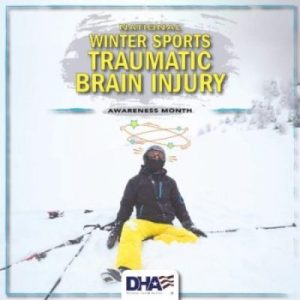
January is National Winter Sports TBI Awareness Month. Knowing just how common these injuries are in winter sports can help us take steps to prevent some of these brain injuries.
General Athlete
- Professional Action Sport Athletes’ Experiences with and Attitudes Toward Concussion: A Phenomenological Study. Qualitative Report, 2016. Generally, athletes accepted concussion risk as part of their sport, but were largely unfamiliar with what concussion was and what long-term effects could result from a history of concussion.
- I won't let you down; why 20% of Men's and Women's Super League Players Underreported Suspected Concussions. Journal of Science and Medicine in Sport, 2023. A player's attitude towards concussion is potentially an individual modifiable risk factor and should be considered within the concussion management of players.
- The Crash Reel. (2013, 109 min film). The dramatic story of one unforgettable athlete, Kevin Pearce; one eye - popping sport, snowboarding; and one explosive issue, Traumatic Brain Injury.
- Wipe Out (2008, 51 min). Narrated by Olympic gold medalist Ross Rebagliati, Wipe Out tells the story of three young men living with permanent brain damage as the result of head injuries they suffered pursuing extreme sports.
Helmet Use
- Helmet Use in Winter Sport Activities—Attitude and Opinion of Neurosurgeons and Non-Traumatic-Brain-Injury-Educated Persons. Acta Neurochirurgica, 2011
- Cohort Study on the Association Between Helmet Use and Traumatic Brain Injury in Snowboarders from a Swiss Tertiary Trauma Center. World Neurosurgery, 2015. Since the introduction of helmets in winter sports there is on-going debate on whether they decrease traumatic brain injuries (TBI).
- Analysis of a Severe Head Injury in World Cup Alpine Skiing. Medicine and Science in Sports and Exercise, 2015. Traumatic brain injury (TBI) is the leading cause of death in alpine skiing…knowledge on optimal helmet performance criteria in World Cup alpine skiing is currently limited owing to the lack of biomechanical data from real crash situations.
Injury Prevention
- Quick Tips: Avoid Traumatic Brain Injury While Playing Winter Sports. Neurology Now, 2014.
- Helmets for Winter Sports. Seattle Children’s Hospital patient information page in English and Spanish.
- How to Avoid a Common Winter Sports Injury. UW Medicine video library (2022, 1:38 min short).
Children & The Elderly
- Outcome of Elderly Patients Injured at Winter Resorts. The American Journal of Emergency Medicine, 2011.
- Traumatic Brain Injury in the Elderly after a Skiing Accident: A Retrospective Cohort Study in a Level 1 Emergency Department in Switzerland. PloS one, 2022. This study aimed to evaluate the importance of traumatic brain injury (TBI), especially in the elderly, after a ski accident, and to describe its short-term repercussions.
- Environmental Factors and Severe Pediatric Trauma following Winter Sliding Sport Injuries. Scandinavian Journal of Medicine & Science in Sports, 2020.
- Me & My New Brain (2015, 51 min). A remarkable programme that reveals what it's like to suffer and then try to live with the most common hidden disability to affect young adults - traumatic brain injury.
- Sledding While Towed behind Motorized Vehicles Associates with More Severe and Lethal injuries. Journal of Pediatric Surgery, 2022. Children experiencing sledding accidents while being towed by motorized vehicles sustain significantly more severe injuries and require more intensive treatments…
Women Athletes
- Woman Athlete Diagnosed with CTE Brain Disease in 'Landmark' Find. AFP International Text Wire in English, 2023.
- These Young Female Athletes Died by Suicide. They All had Head Injuries in Common. CNN Wire, 2023.
- “Invisible Sportswomen”: The Sex Data Gap in Sport and Exercise Science Research. Women in Sport & Physical Activity Journal, 2021. This study aimed to conduct an updated exploration of the ratio of male and female participants in sport and exercise science research.
- Head Injuries Are Not Just Major Concern in Football. Today transcript, 2019. Typically, researchers looked at former football players, but now leader in the field is turning towards women who play soccer. Why? Because frequent headers are so key to the sport.
- Risk and Susceptibility to Repetitive Subconcussive Head Injury: Evidence for Sex as a Risk Factor and a New Model for Further Investigation. ProQuest Dissertations Publishing, 2019. One domain that has been postulated to confer risk is biological sex, as women report more concussions than men, and take longer for post concussive symptoms to resolve.
Image Credit: Military Health System. (2023). National Winter Sports Traumatic Brain Injury Awareness Month. Retrieved December 29, 2023.